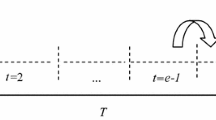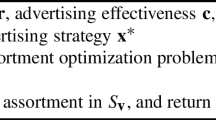Abstract
A product passes through different life cycle phases once it comes in the market. During the launch phase it is promoted on mass level, second phase stresses on capturing maximum potential, and in later phases company emphasizes on retention of the product in the minds of the customers until its continuation in the market. The advertising budget and media mix used to advertise the product must be planned according to the current phase of the product. Thus it becomes imperative for a company to look at media planning problems in a dynamic manner over a planning period as the market conditions change and the product moves through its cycle with time. In this paper we have formulated a multi-period mathematical programming problem that dynamically computes the optimal number of insertions and allocates advertising budget in various media channels of a segmented market. The aim is to maximize the reach obtained through each media from all the segments in each time period under budgetary constraints and bounds on the decision variables. The reach in any period for a media is taken as a sum of current period reach and retention of the previous periods reach. Goal programming technique is used to solve the problem. A case study is presented to show the real life application of the model.
Access this chapter
Tax calculation will be finalised at checkout
Purchases are for personal use only
Similar content being viewed by others
References
Balakrishnan, P.V., Hall, N.G.: A maximin procedure for the optimal insertion timing of ad executions. Eur. J. Oper. Res. 85, 368–382 (1995)
Bhattacharya, U.K.: A chance constraints goal programming model for the advertising planning problem. Eur. J. Oper. Res. 192, 382–395 (2009)
Charnes, A., Cooper, W.W., DeVoe, J.K., Learner, D.B., Reinecke, W.: A goal programming model for media planning. Manag. Sci. 14, 422–430 (1968)
Geoffrion, M.A.: Proper efficiency and vector maximization. J. Math. Anal. Appl. 22(3), 618–630 (1968)
Jha, P.C., Aggarwal, R., Gupta, A.: Optimal media planning for multi-product in segmented market. Appl. Math. Comput. 217(16), 6802–6818 (2011)
Kumar, A.J.: Quantitative model for press media planning in India. Vikalpa. 1(1), 39–50 (1976)
Mihiotis, A., Tsakiris, I.: A mathematical programming study of advertising allocation problem. Appl. Math. Comput. 148(2), 373–379 (2004)
Moynihan, G.P., Kumar, A., D’Souza, G., Nockols, W.G.: A decision support system for media planning. Comput. Ind. Eng. 29(1), 383–386 (1995)
Pasadeos, Y., Barban, A., Huiuk, Y., Kim, B.-H.: A 30-year assessment of the media planning literature. J. Curr. Issues Res. Advert. 19(1), 23–36 (1997). doi:10.1080/10641734.1997.10505055
Royo, C.B.: Zhang, Blanco, L.A., Almagro, J.: Multistage multiproduct advertising budgeting. Eur. J. Oper. Res. 225(1), 179–188 (2013)
Thiriez, H.: OR software LINGO. Eur. J. Oper. Res. 12, 655–656 (2000)
Author information
Authors and Affiliations
Corresponding author
Editor information
Editors and Affiliations
Appendices
Appendix A
Let f (X) and b be the function and its goal respectively and η and ρ be the over and under achievement (negative and positive deviational) variables then the choice of deviational variable in the goal objective functions which has to be minimized depend upon the following rule:
-
if f (X) <= b, ρ is minimize under the constraints f (X) + η − ρ = b
-
if f (X) >= b, η is minimized under the constraints f (X) + η − ρ = b and
-
if f (X) = b, η + ρ is minimized under the constraints f (X) + η − ρ = b
Appendix B
Definition 1
[4]: A solution x 0 is said to be efficient solution if x 0∈S and there exist no other feasible point x such that F(x) ≥ F(x 0 ) and F(x) ≠ F(x 0 ).
Definition 2
[4]: A solution x 0 is said to be a properly efficient solution if it is efficient and if there exist a scalar M > 0 such that, for each i, we have \( \frac{{f_{i} (x) - f_{i} (x^{0} )}}{{f_{j} (x^{0} ) - f_{j} (x)}} \le M \). For some j such that f j (x) < f j (x 0) whenever x∈X and f i (x) > f i (x 0)
Lemma 1:
Through definition 1 and 2, optimal solution of the problem (P5) will be properly efficient solution to the problem (P3).
Appendix C
Rights and permissions
Copyright information
© 2014 Springer India
About this paper
Cite this paper
Aggarwal, S., Kaul, A., Gupta, A., Jha, P.C. (2014). Multi Period Advertising Media Selection in a Segmented Market. In: Pant, M., Deep, K., Nagar, A., Bansal, J. (eds) Proceedings of the Third International Conference on Soft Computing for Problem Solving. Advances in Intelligent Systems and Computing, vol 259. Springer, New Delhi. https://doi.org/10.1007/978-81-322-1768-8_76
Download citation
DOI: https://doi.org/10.1007/978-81-322-1768-8_76
Published:
Publisher Name: Springer, New Delhi
Print ISBN: 978-81-322-1767-1
Online ISBN: 978-81-322-1768-8
eBook Packages: EngineeringEngineering (R0)




